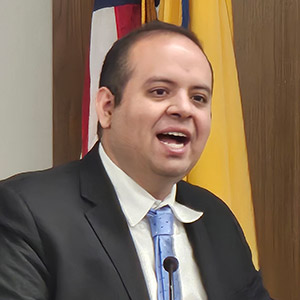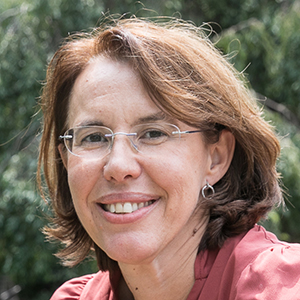A new technology developed by NIEHS grantee Manish Arora, Ph.D., may predict future diagnoses of neurodevelopmental and neurodegenerative conditions with a single strand of hair. Known as StrandDx, this test may help doctors by providing presymptomatic identification of risk for conditions such as autism years before symptoms appear.

First developed at Mt. Sinai Hospital with support from multiple NIEHS grants over the years, including the current NIEHS Revolutionizing Innovative and Visionary Environmental Health Research (RIVER) grant, StrandDx works by recognizing biological markers, or biomarkers, of disease in the human body. These markers, measured at over 500 time points, are produced in response to specific environmental exposures.
“This research combines sophisticated molecular techniques and advanced exposure science to predict the likelihood that an infant or young child will go on to receive an autism diagnosis, enabling closer monitoring, and an opportunity for earlier interventions, therapies, services, and supports for children,” said Cindy Lawler, Ph.D., who leads the Genes, Environment, and Health Branch in the Division of Extramural Research and Training (DERT).
Lawler, together with DERT Health Scientist Administrators Yuxia Cui, Ph.D., and Kimberly Gray, Ph.D., oversaw the NIEHS grants that supported development of the new test.
From collecting teeth to splitting hairs
Though Arora initially trained as a dentist, he was always drawn to environmental health. During graduate school, he became interested in what was viewed as an unsolvable problem at the time: how to detect past exposures from present data. His knowledge of teeth led to a solution.
“I was looking at the growth rings of a tree that had been cut down, and I noticed one that was unusually thin and irregular,” Arora said. “Then it struck me that there must be something in the body that similarly records our history, and I remembered that baby teeth have growth rings too.”
Based on this insight, Arora received NIEHS funding (DP2ES025453 and R00ES019597) to investigate ways to detect certain metals — including lead and arsenic — in teeth long after the initial exposure. Tracing these metals is important because they have been linked to neurodevelopmental disorders such as autism.
Although baby teeth can help diagnose some diseases and disorders, they also have limits. Teeth cannot be collected at the point-of-care. Arora searched for a different tissue that could be used as a predictive tool in young children even before they lose their teeth. An NIEHS RIVER grant provided Arora with broad funding to look for early warning signs of childhood and adult medical conditions.
“I wanted to find a tissue that could be of practical use to doctors and patients, and then it hit me that hair also has growth rings in it and can be collected noninvasively whenever a clinician needs to assess a patient,” Arora said.
Putting environmental theory into practice

Arora suggested that to understand the interaction between our genes and environment, researchers must study the time dimension, or temporal resolution. To achieve this, Arora developed a technology that can measure our environmental exposures at over 500 time points with a single strand of hair.
Having found a target tissue, Arora and his team set out to identify specific biomarkers linked to an autism diagnosis. In one study, they analyzed levels of various metals in hair samples collected from infants at one month of age and then studied these levels prospectively for over 5 years. The researchers found different patterns of metal uptake and metabolism in those samples from infants who were later diagnosed with autism compared to those with typical development. They replicated these findings in twins in a study in Sweden and then again in patients at Mount Sinai hospital.
That work led to the development of StrandDx — a technology platform that takes a time series of chemical exposures in a strand of hair to help predict diseases and disorders. The technology effectively harnesses the power of exposomics, a branch of health science that studies the totality of all environmental exposures and the body’s response to them across the lifespan. In its first application, StrandDx uses proprietary robotic platforms and lasers to slice open human hair and analyze it for the patterns of skewed metal metabolism linked to autism.
“Our main focus right now is on the prediction of autism, in part, because it is a major global health challenge,” said Arora. “We went from one in 10,000 cases in 1970 when I was born to one in 36 today, and I think exposomics must be a factor.”

To bring this technology to market, Arora and his team launched the company LinusBio. They have already received a “breakthrough device” designation for StrandDx from the U.S. Food and Drug Administration (FDA). The Breakthrough Devices Program is a voluntary program for certain medical devices and device-led combination products that provide for more effective treatment or diagnosis of life-threatening or irreversibly debilitating diseases or conditions. According to Arora, the designation will help to streamline the FDA approval process, and his team hopes to make the test publicly available sometime this year.
“I’m a lifelong academic, and I never imagined that I would be at the helm of a company,” he said. “But once this biomarker [for autism] had been developed, I saw the immense public health impact, and I felt a responsibility to bring it to the point it was available to communities in need.”
In March, LinusBio’s hard work in developing StrandDx was recognized by Fierce Medtech, a medical technology industry publication. LinusBio was one of 15 companies named to Fierce Medtech’s “Fierce 15” list.
Charting the future of StrandDx
Besides autism, LinusBio is currently developing biomarkers for several conditions, ranging from attention deficit hyperactive disorder to amyotrophic lateral sclerosis. In the future, Arora believes that these biomarkers could also be used to help develop therapeutic treatments.
“You want one solution to 100 problems, and that was always the vision for StrandDx,” he said. “I think a lot of credit should go to NIEHS and the RIVER grant mechanism because it gave us the broad scope to build a platform that addresses multiple different conditions.”
(Ben Richardson, Ph.D., is a Presidential Management Fellow in the NIEHS Office of Communications and Public Liaison.)









